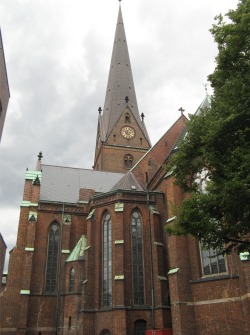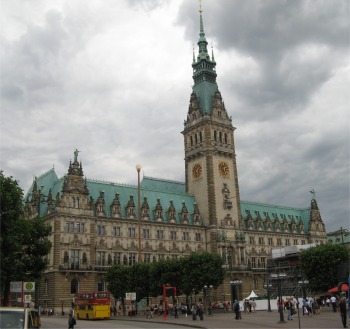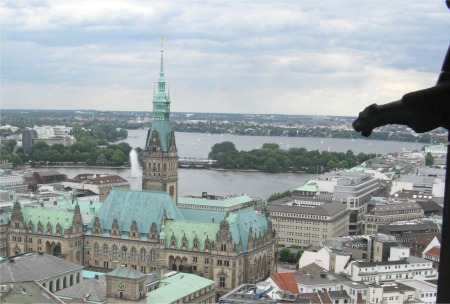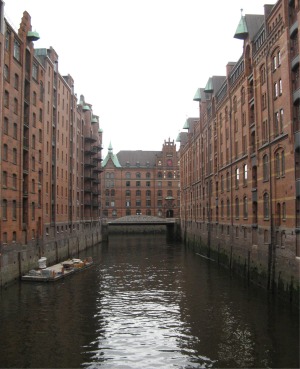 St Jacobi Church |
 St Petri Church |
My interrogators then pointed to a phrase in the document they had presented me with, and with the help of a dictionary I picked up the context of espionage. I blurted out in my best German, "I am not a spy!" The officials smiled and I was in. I guessed the document must have been akin to our UK Official Secrets Act.
 Rathaus |
We alighted at this great city, and after obtaining a set of maps, we set off to explore some of the historic buildings and districts.
Our first port of call was the St Jacobi Church, founded in the 13th century, and home to the famous Arp Schitger organ. From the outside it was an imposing red brick building with a modern looking spire. Inside it was simply adorned, but still functioned as a church. The church had been destroyed by bombs in 1944, and was rebuilt in the modern brick style some years later. The 17th century organ and paintings must have been stored somewhere safe during the war. We had a chat with the woman on the door, who seemed desperate to have someone to talk to. She could speak some English since she had spent a little time in Surrey, and she could also turn out a tolerable Australian accent. She had spent a few years in Brisbane; her sister was still there. The woman went on and on, telling us all about her sister's drink problem, and how she belonged to a self help group. We managed to escape when some other souls appeared.
 Aussenalster and Binnenalster beyond the Rathaus |
We moved on to the St Nikolai Monument, once the third highest church in Germany, it was burned out in the Hamburg firestorm in 1943, "Operation Gomorrah". Today it was a monument to the victims of war, violence and persecution. The tower of the church remained; very little else. A lift gave access to a viewing platform high up in the tower, which afforded splendid views across the city.
Illustrated boards on the viewing platform showed photographs of the views seen in front of them, but taken just after the war, when the city lay in ruins. A board also gave an account of the bombing, but more importantly it presented an open acknowledgement of the terrible build up to the war by Germany. The actual script follows:
The Destruction of Hamburg During World War II
 St Nikolai Monument |
Hamburg's eastern areas were especially hard hit. The three districts of Hammerbrook, Rothenburgsort and Hamm-S�d were completely destroyed by the firestorm and had to be declared prohibited areas. Prisoners from Neuengamme concentration camp were forced to recover the bodies , clear the rubble and defuse unexploded bombs.
In total, the bombings completely destroyed 255,691 flats. At the end of the war 902,000 inhabitants of Hamburg had lost all their belongings and another 265,000 had lost parts of their property, most of them during "Operation Gomorrah".
These images of destruction remind us of the cruelty which Nazi Germany spread all over Europe with its war of aggression and annihilation. It has rightly been pointed out that the carpet bombings of residential areas were in breach of international law, cruel, and not the right instrument for breaking the German masses' loyalty to Hitler. However, the fuse for the firestorm was lit in Germany. The German air-raids on Guernica(1937), Warsaw(1939), Coventry and Rotterdam(1940), London(1941) and many other cities in Western and Eastern Europe preceded the destruction of Hamburg.
The original catastrophe occurred ten years earlier, in 1933, when the National Socialists with support of large parts of the elite and the population abolished democracy and the rule of law within a matter of weeks. This catastrophe was to bring on all the other tragedies that followed, such as the air-raids and later the expulsion of the German population from Eastern and Central Europe as well as the partition of Germany. Ultimately the dead, injured, and homeless of the air-raids, too, were victims of Nazi Germany's politics of aggression, its claim for world domination and its barbarisation of war.
 Spent a Week at the Top During My Training in 1970 |
 Speicherstadt |
We ambled down to the Elbe River, where we parted company; Alan wanting to spend the rest of the day at the Maritime Museum. He later reported on how colossal it was, and he had only visited seven out of the nine floors before being asked to leave at closing time.
Meanwhile, I headed out onto Cap San Diego, a pier out in the river, where a large German warship was moored. I, like many others, only discovered on reaching the warship that it would not be open to the public until the following day. The people I could see on board must have been attending a private function, for which all the ship's officers were kitted out in immaculate uniforms.
Failing to be deterred, I carried on along the river side to the SS Rickmer Rickmers, a beautiful windjammer, built in 1896 as a full-rigged ship in Bremerhaven. In years gone by it had worked the East Asia shipping route, before ending up as a depot ship.
A group of Hamburg citizens, as part of the registered society "Windjammer for Hamburg", bought the vessel, and after much refurbishment the ship was moored in its current location in 1983. It now served as a museum and restaurant. I went aboard, and the refurbishments had indeed been immaculate. Sadly only the foredeck could be visited since the rest of the ship was being used for private functions (I guess the society saw this as more of a business venture than a pure museum). I was a bit miffed that I had been conned into paying to enter a museum that was almost totally closed.


